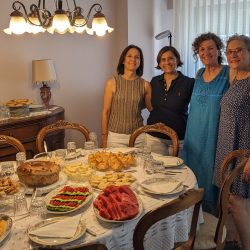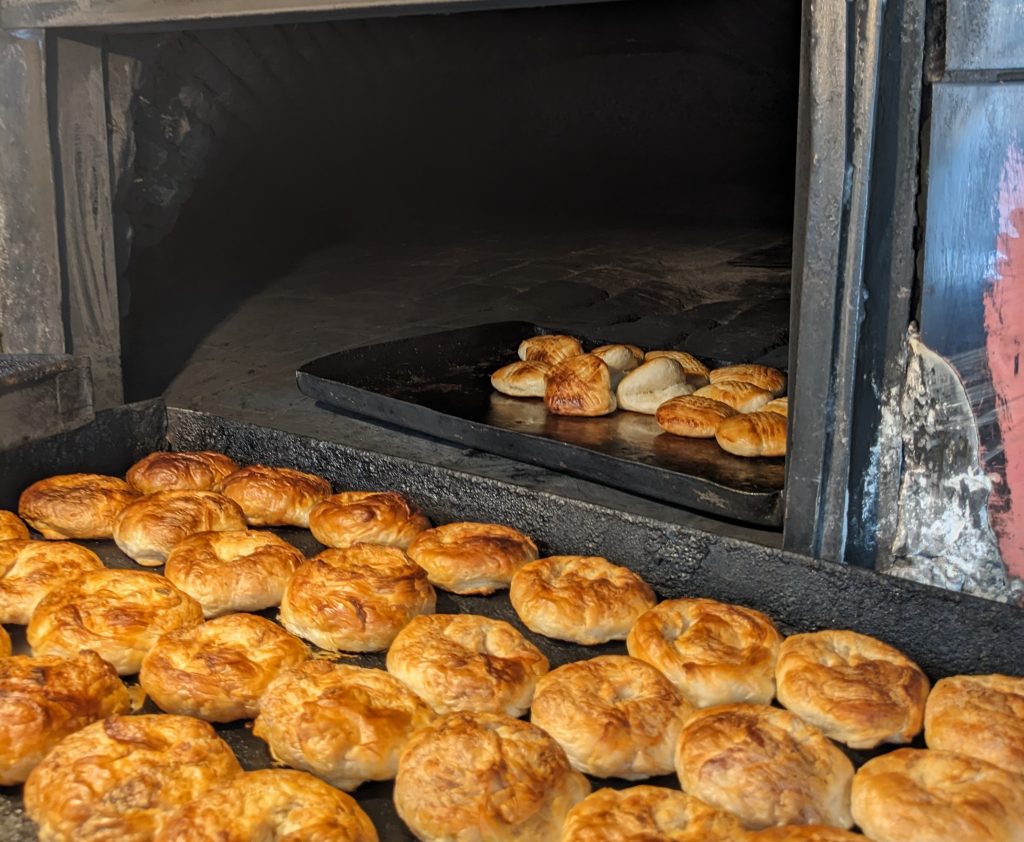
We left off our series of blog posts about our trip to Turkey with our visit to Büyükada Island near Istanbul, where we had the pleasure of learning from our new Sephardic friend, Luna. On our last day in the area of Istanbul, we returned to the mainland, to the Beyoğlu district, where we explored the old Jewish neighborhoods and markets. Lian’s aunt, Simone, was leading us this time, weaving through crowded streets where the old and new blended nonchalantly while she shared memories of growing up in this part of Istanbul. The food highlights of the day were stops at the generations-old Turkish Delight shop, Hacı Bekir, in Beyoğlu and Güllüoğlu Baklava shop in Karaköy. Needless to say, hearing about the history and intricacies of lokum (the Turkish word for Turkish Delight) and baklava, and then tasting them with intention, was an enriching and quite a filling experience.
The next leg of our trip was Izmir, a quick flight from Istanbul to the western, Aegean coast of the country. Izmir has seen Jews as part of its population since ancient times. A more recent wave arrived when the Jews expelled from their homes during the Spanish Inquisition found refuge in the Ottoman Empire starting in the 15th century. As the city became an important trading center, it further attracted Jews from surrounding areas in Turkey, including Istanbul, but also from outside, such as Italy and islands in the Aegean and Mediterranean. After World War II, many Jews left the area for the newly founded state of Israel as well as America and Europe, diminishing their population from tens of thousands in its heyday by the end of the 19th century to around 2,000 today.
Our local guide, Nuket Franco, originally from Istanbul, was highly recommended to us by our friend, Ansel Mullins, the founder of the extraordinary food tour company, Culinary Backstreets. She is a trained tourist guide—who happened to have been trained together with our Istanbul tour guide, Uğur—and also intimately engaged with the preservation of Izmir-ian Sephardic culture. She arranged a couple of days for us to do some hands-on cooking with her friends from the Sephardic community and tour the old Jewish neighborhoods and markets of the area. Before cooking with Nuket and her friends, I wanted to explore boyoz (the Turkish word), or bollos (the Ladino word, meaning bun or bread roll), the snack that came up when I was originally researching Sephardic foods in Turkey.
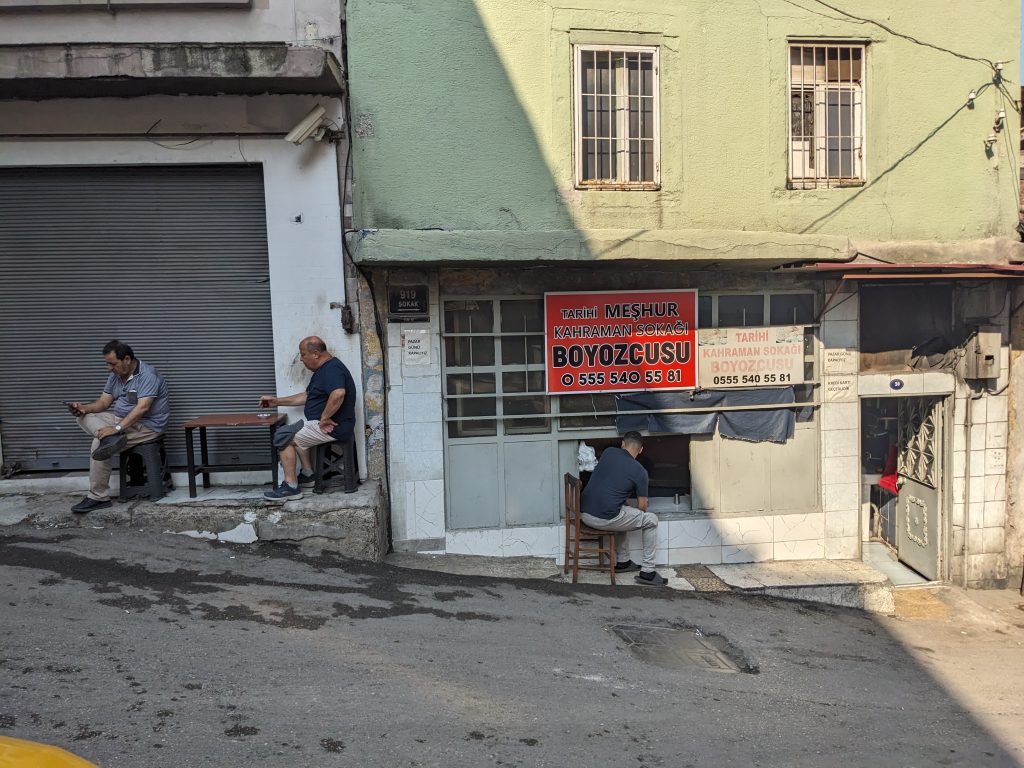
First thing in the morning, I visited a bakery known for its boyoz, a savory, laminated pastry of Sephardic origin that is commonly (and uniquely) consumed in the Izmir region of the country. I knew that we were going to make this pastry during our hands-on workshop, but I wanted to experience a really good version from a local bakery as well. So, I took a cab across town to the Tarihi Kahraman Sokaği Boyozcusu (translated as Historic Kahraman Street Boyoz Bakery). The cab driver told me that we were going to an old, commercial part of the city. This became apparent to me as we got closer to our destination.
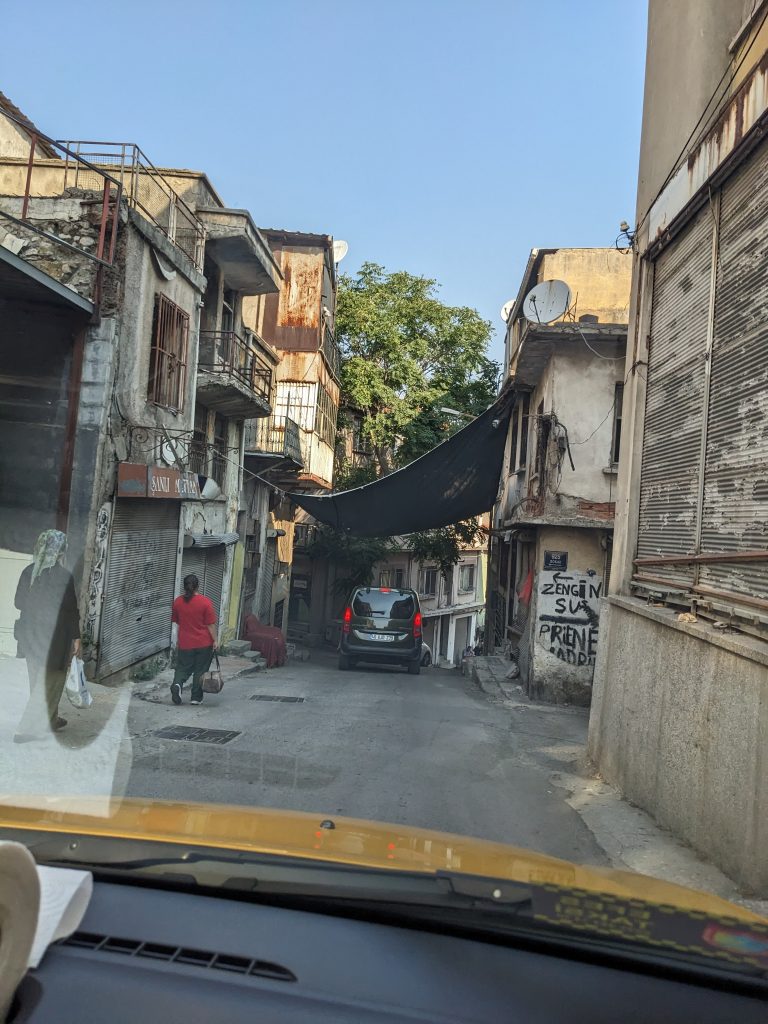
There was the morning hustle and bustle—cars, trucks, quickly-walking pedestrians, shops upon shops right next to each other with residences right above. Making a right off the main street, I started wondering if we were at the right place, as the street was really narrow, and seemed to have no space for a bakery, which left me slightly confused and anxious. But the unassuming red sign hanging above a tiny pick-up window helped me spot this local gem. Like its sign and location, this was a no-frills bakery operation that’s been going on for more than 80 years. The current head baker and owner, Ali Ihsan, is instantly approachable with a warm smile under his moustache. He learned the craft from his usta (or master) starting as an apprentice in 1974. Nowadays, he is helming the operation together with his wife.
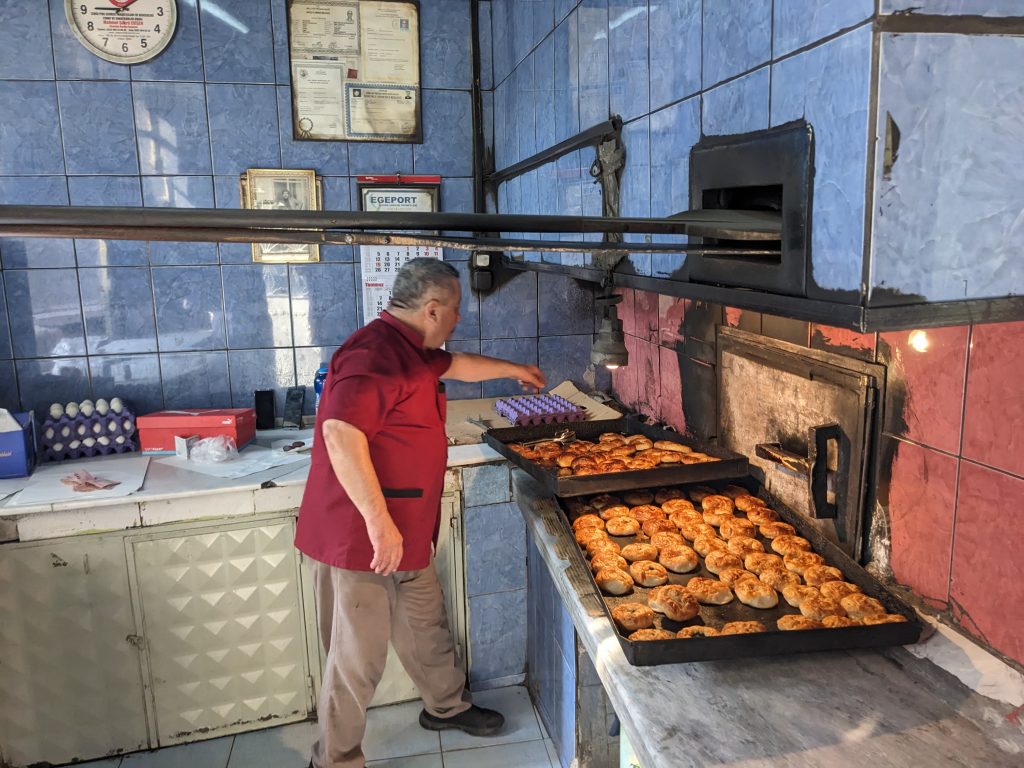
When I walked in, rolls of boyoz immediately caught my eye with their golden glory neatly arranged in well-seasoned rectangular pans against the wood-fired brick oven they were coming out of. I heard a customer ask for some boyoz and watched the order getting fulfilled in a matter of seconds. Ali usta deftly picked up the boyoz, turning around to put it on butcher paper on the counter facing the shop’s small pick-up window while his wife, a few feet away from him, cleanly sliced an oven-baked egg using a string attached to the counter wall.
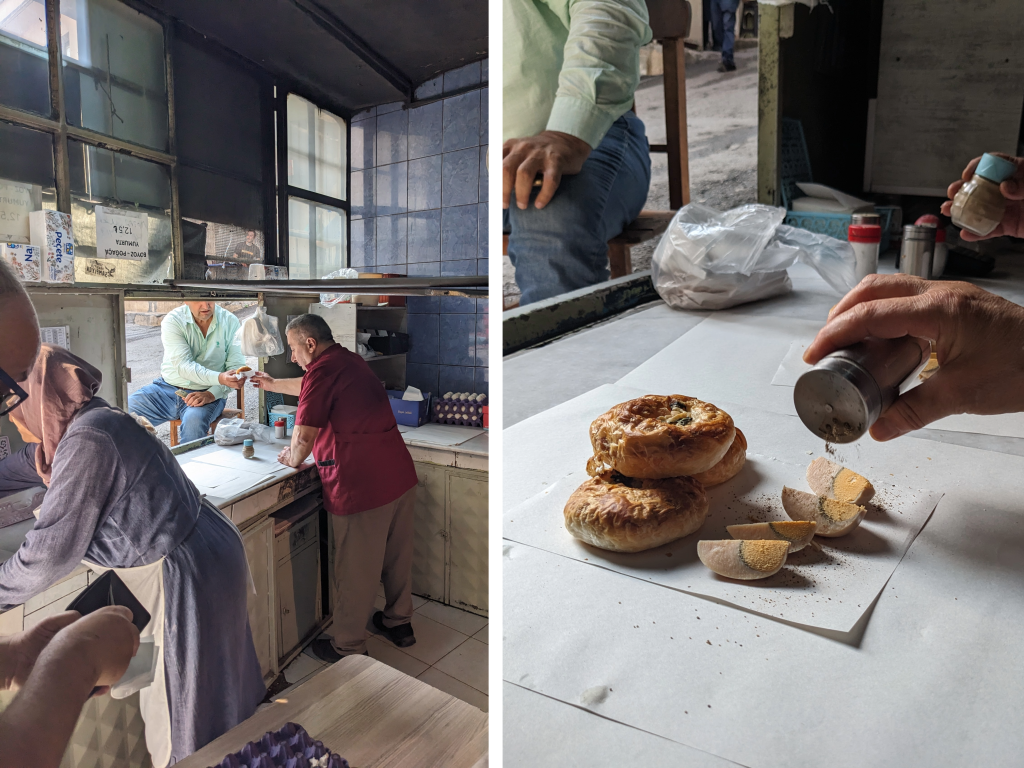
She passed the sliced egg to her husband who then swiftly seasoned it with salt and pepper before wrapping the whole thing up and placing it in a plastic bag to pass on to their customer. Ali usta makes just a couple of flavors of boyoz—plain and spinach—selling all of it from six in the morning until noon. I ordered a few of each for my group and the cab driver.
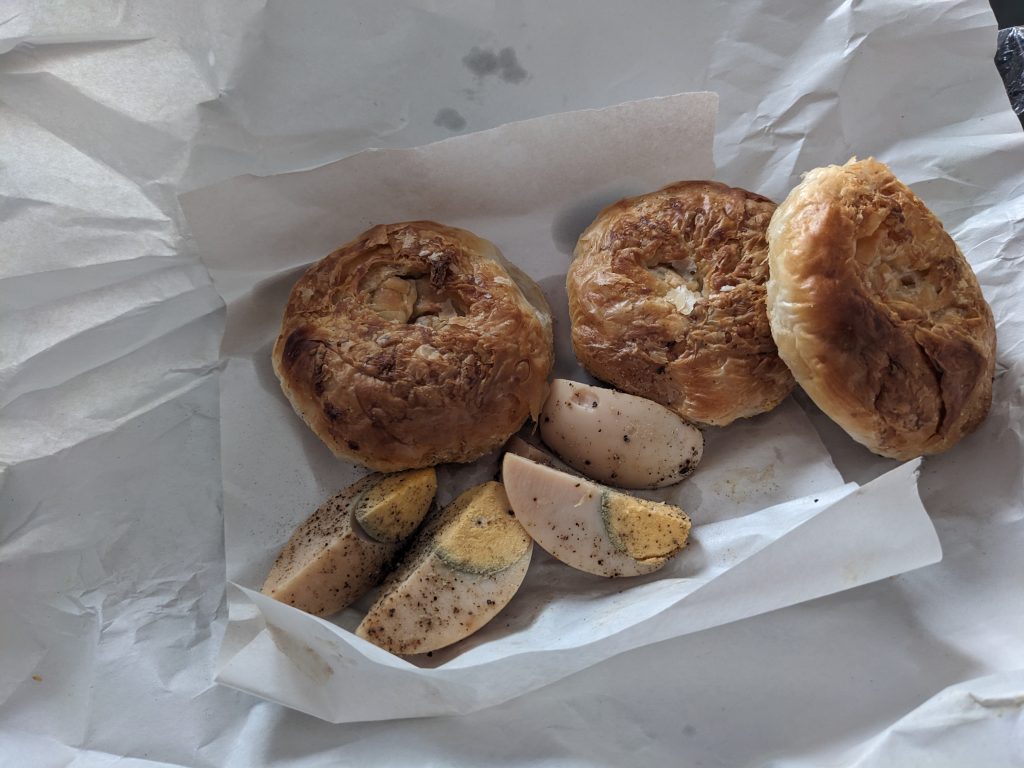
Back at the hotel, in our rush to get out the door again for the workshop, I slowed down for a second to savor a bite of the boyoz. It had an amazing crunch and flakiness with subtle toasted flavors. It was slightly oily, yet not too heavy, not too light…just the comforting morning snack to go along with, yes, Turkish tea. The ready-to-eat perfectly seasoned eggs had a slight brownish hue and a nutty flavor and they added substance to this quick meal.
The story* of today’s boyoz in Izmir began with Sephardic Jews bringing it with them from their Spanish homes to their newly adapted city. Initially, their technique of preparing boyoz at home—kneading a simple dough, thinning it, and laminating it with oil—did not change much despite new ingredients they had access to. Boyoz was especially suited for Shabbat on Saturdays as it could be prepared and cooked on Friday and held until the next day, when no cooking or meal preparation would take place. As demand increased, home boyoz makers started bringing the prepared, uncooked boyoz to bakeries in Jewish neighborhoods that could bake it for them to be sold on street carts. It was this act that eventually led to commercial preparation and sale of boyoz in bakeries in the early part of the 20th century.
The lamination also evolved with non-Jewish Turkish bakers, mainly from the Thrace (Rumeli) region, apprenticing under their Jewish usta and introducing their region’s serpme technique (flinging the dough in the air with their hands/arms) which could stretch a large amount of dough really thin in a short amount of time, a technique that was common for making Turkish borek pastry. This meant flakier boyoz that could be made very efficiently in large batches, allowing it to become more mainstream.
Today, it shines as a beloved street food associated with Izmir, made in many bakeries throughout the city. Amy points out, how Sephardic bollos became part of Izmir’s culture is not so dissimilar from how bagels found their place in the United States by way of the culinary heritage of Jews arriving from Eastern Europe.
Next we learn to make boyoz at home.
*Reference: İzmirlinin Zihin Dünyasında Bir Yahudi Böreği: Boyoz by Nejat Yenturk.
Originally from the island of Cyprus, Hazim decided to immerse himself in the world of bread baking and all foods fully flavorful after a career in environmental engineering. He joined the Bakehouse team in 2016 with a focus on bread quality and innovation. You may find him at the bench with his baker friends rolling Farm dough, milling flours on our stone mills, teaching a Naturally Leavened Bread class at BAKE!, tasting breads, loudly (he calls it "passionately") elaborating on the benefits of whole-grain flours or temperature for sourdough baking, or stopping in his tracks to think about the next possible bread or improvement. Science is dear to him, and he loves windsurfing!! He was recently featured on Rise Up! The Baker Podcast with Mark Dyck talking about getting his start in baking, the tension of leaping into a new career, and working on a team where he can be his whole self.

